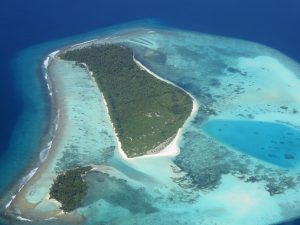22 November 2017
Scientists counter threat of flooding on coral reef coasts
Posted by Nanci Bompey

A low-lying island within the Maldives archipelago in the Indian Ocean. CC0 Public Domain.
Scientists have developed a computer simulation tool to predict short-term flood hazards on coral-reef-lined coasts and to assess longer-term impacts from climate change. The assessments will give input to estimate societal or economic risk and damage from such flooding. The tool can be used to play “what-if” games and ask questions such as, “how will flood risk change if the coral on this reef dies, or if sea level rises by more than 1 meter?”
By Roeli Suiker
Hurricanes Harvey, Irma, Jose, and Maria became household names this fall as they tore a path of destruction through the Caribbean and southern United States. The waves generated by such hurricanes or cyclones can have devastating effects on low-lying tropical coasts fronted by coral reefs. Scientists have developed a tool called “BEWARE”: Bayesian Estimator of Wave Attack in Reef Environments for predicting flooding caused by waves on coral reef-lined coasts. Their results were published this month in the Journal of Geophysical Research: Oceans, a journal of the American Geophysical Union.
Thousands of islands threatened
Coral reef-lined tropical coasts face the threats of climate change, sea-level rise, and coral degradation. Many of these islands are less than three meters (10 feet) above mean sea level, with their freshwater in thin, fragile aquifers just beneath the surface of the ground. This makes residents of such coastal areas extremely vulnerable to sea-level rise and flooding caused by waves, which can threaten their food and water supply, public health, and critical infrastructure. Population growth and the impact of climate change are expected to escalate such hazards.
Flood prediction: a challenging task
However, “it is quite challenging to predict flooding caused by waves along coral reef-lined coasts,” said Stuart Pearson, a coastal engineering doctoral student at Deltares and Delft University of Technology in Delft, Netherlands and lead author of the study. “This is because coral reefs differ widely in their physical structure. Furthermore, the wave and sea level conditions affecting them often vary significantly in space and time. For many locations, there are little to no data available regarding these factors. The task of coastal flood prediction is made even more difficult by the complex changes that waves undergo as they move across coral reefs and approach the shore.”
Tackling the problem
BEWARE solves the challenge of working in regions with poor data availability by generating an artificial database of wave conditions on coral reefs using the physics-based XBeach Non-Hydrostatic wave model. These data are compiled in a statistical Bayesian network model that enables the kind of fast predictions needed to power early warning systems for coastal flooding. By feeding BEWARE information about waves and sea level plus the structure of the reef, flood hazards can be predicted at the coastline. “Such tools are key to assess hazards and prioritize efforts to reduce risk and increase the resiliency of coral reef-lined coastal communities,” said Curt Storlazzi, a research geologist at the U.S. Geological Survey and co-author of the study.
— Roeli Suiker is a communications advisor at the Dutch research institute Deltares. This post originally appeared as a press release from Deltares.


 GeoSpace is a blog on Earth and space science, managed by AGU’s Public Information staff. The blog features posts by AGU writers and guest contributors on all sorts of relevant science topics, but with a focus on new research and geo and space sciences-related stories that are currently in the news.
GeoSpace is a blog on Earth and space science, managed by AGU’s Public Information staff. The blog features posts by AGU writers and guest contributors on all sorts of relevant science topics, but with a focus on new research and geo and space sciences-related stories that are currently in the news.